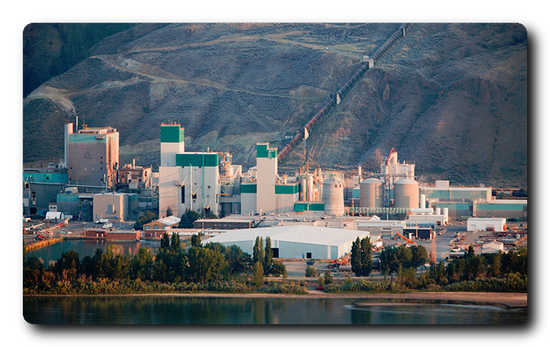When people think of paper manufacturing, the first natural resource that comes to mind is probably trees. But water plays an equally important role in our industry. That’s why sustainable water management is one of our top priorities.
The location of our facilities shows how important water is to our manufacturing process. We’ve built our mills near abundant water supplies, such as the shores of rivers, to draw water for our operations. Managing these natural resources is important to us and to the communities in which we live.
Water Use at Domtar
In 2017, our pulp and paper mills used enough water to fill 164,000 Olympic-sized swimming pools. But because of our extensive water recycling loops, we can reuse that water an average of 10 times in the mill before we treat it one final time in our onsite wastewater treatment plants. Of the water we bring into our mills, about 90 percent is returned to its original source. The other 10 percent evaporates or becomes part of our products and byproducts.
The water we do use — 94 percent of which comes from surface-water sources such as lakes and rivers — does a lot of work. It’s used to wash and transport pulp, dilute and prepare process chemicals, generate steam and electricity, carry energy and raw materials throughout the mill, and clean and cool equipment.

Each of our mills has a unique water footprint. Mill age, the kind of equipment we use and the types of pulp and paper products we produce are the primary drivers of how much water we use.
For example, specialty papers, such as medical paper, require more water to produce than everyday copy paper. That’s because specialty papers are generally manufactured using shorter runs with more grade changes. They also have more stringent quality requirements, such as FDA requirements for food packaging, which can limit opportunities to reuse water.
A Focus on Sustainable Water Management
Some of our mills, first built in the late 1800s, did not include water conservation features in their original design. But as we’ve upgraded them and built new mills, we’ve placed special emphasis on sustainable water management.
We’re doing our part to conserve water. Our mills have reduced total water use by 4 percent since 2013. That means we can now avoid using enough water to fill 6,560 Olympic-sized swimming pools each year.
“Water is a local resource best managed with site-specific strategies,” says Paige Goff, Domtar’s vice president of sustainability. By understanding the unique challenges and opportunities where we operate, we can manage water usage in a way that helps us be better stewards of this shared resource, making our business and communities more sustainable.
As in many other parts of nature, sustainable water management and sustainable forestry work hand in hand. Forests play a critical role in protecting and conserving valuable water resources by recharging ground water supplies, buffering and absorbing storm water surges, and cleaning and protecting the lakes and rivers our mills and local communities depend on. We support the protection of the forested landscapes, forest wetlands and watersheds from which we source forest and water resources.
We also recognize that we literally are connected to our neighbors through the rivers and lakes that supply our water. As we continue to innovate, we are also working to improve water quality and water management so that we can serve as better stewards of these shared resources. Learn more by reading our 2017 Sustainability Report.
